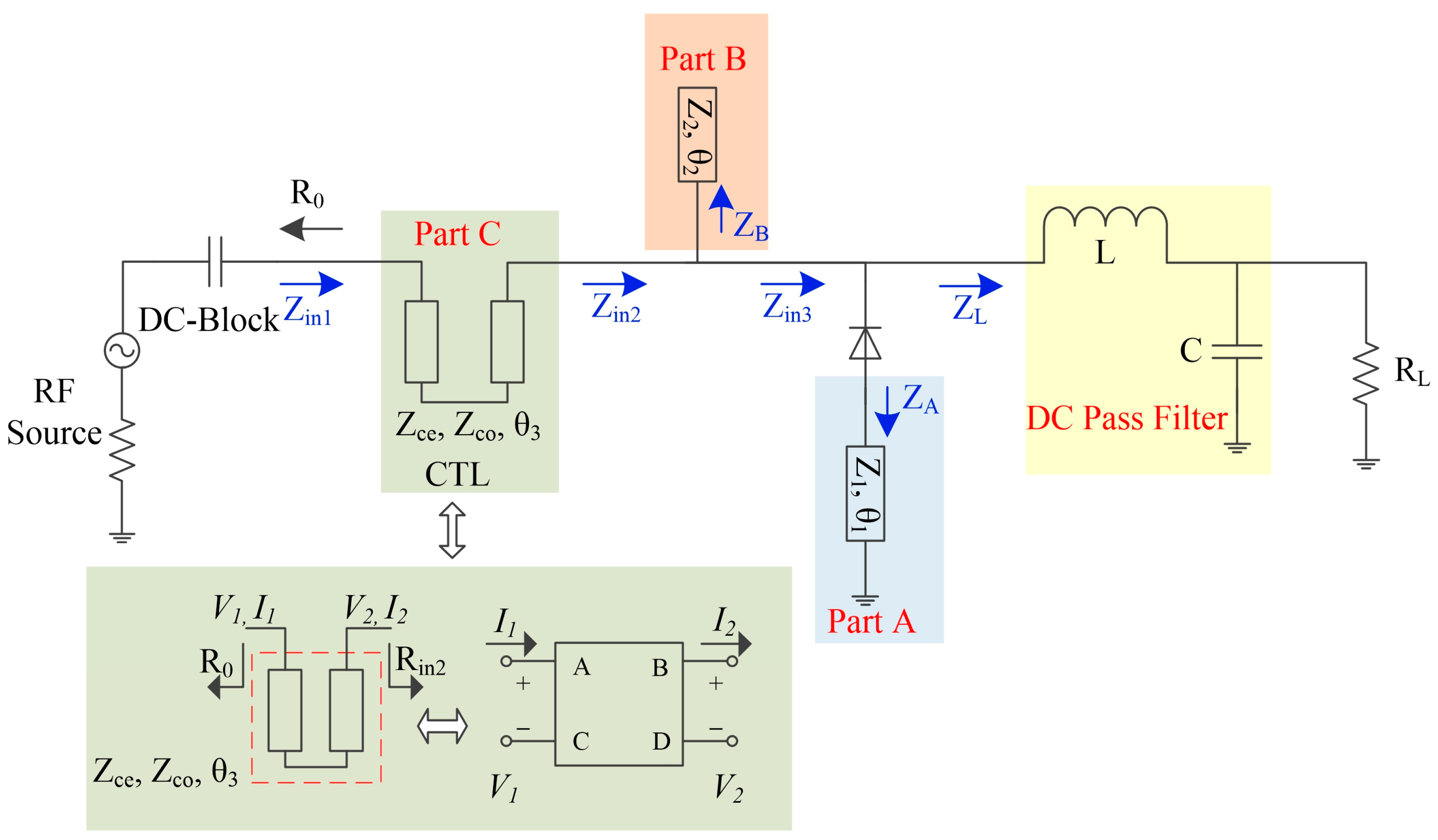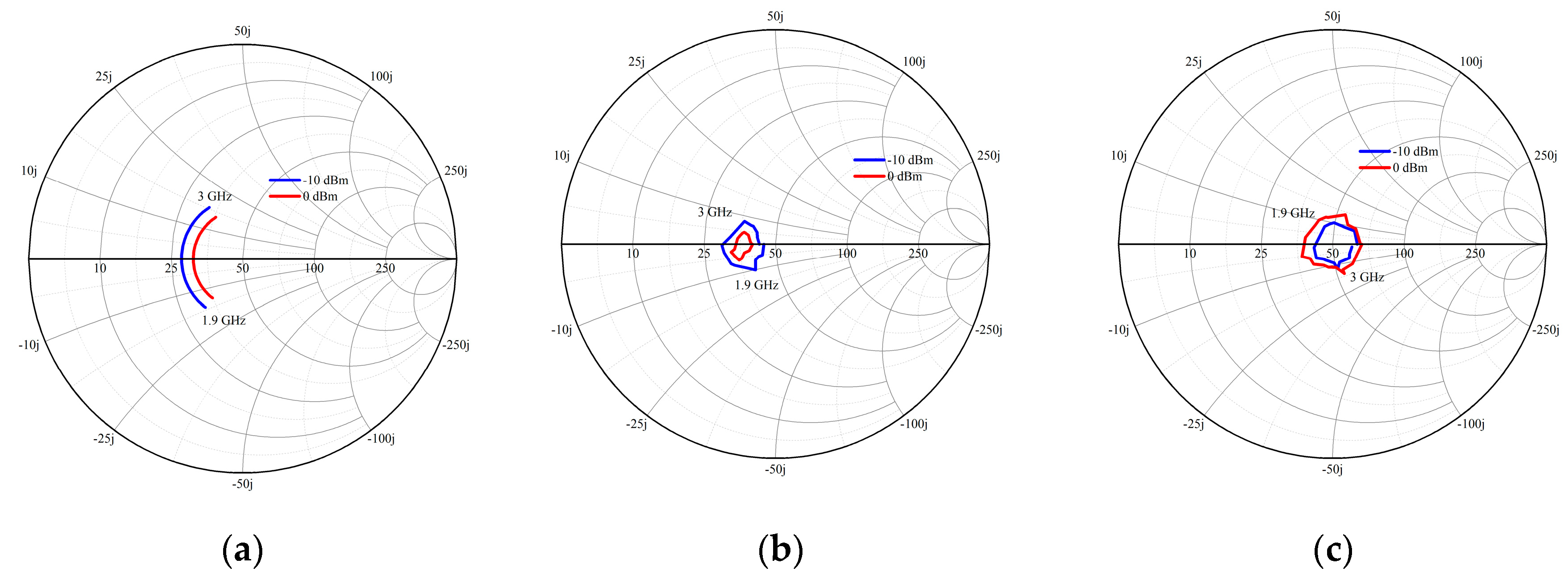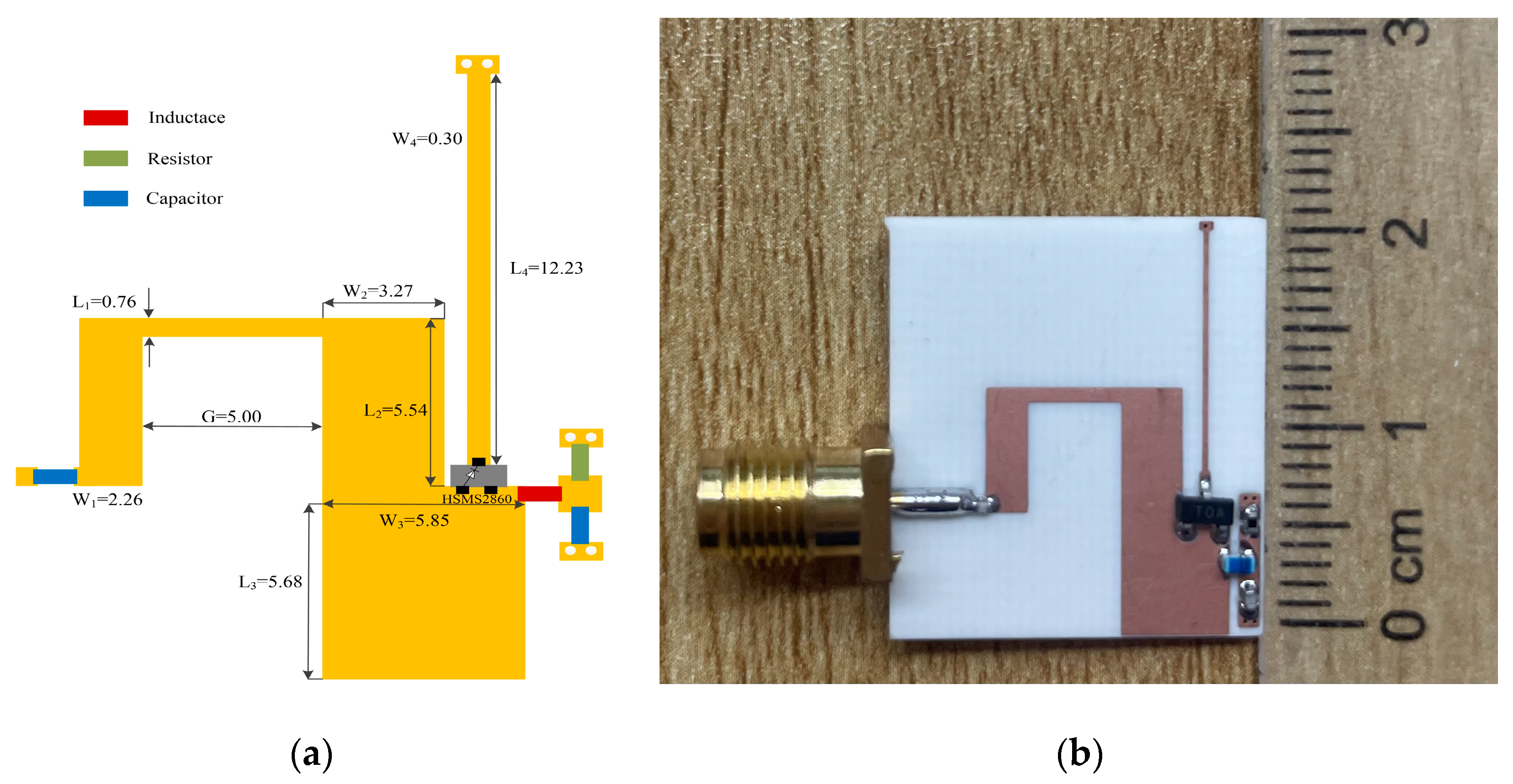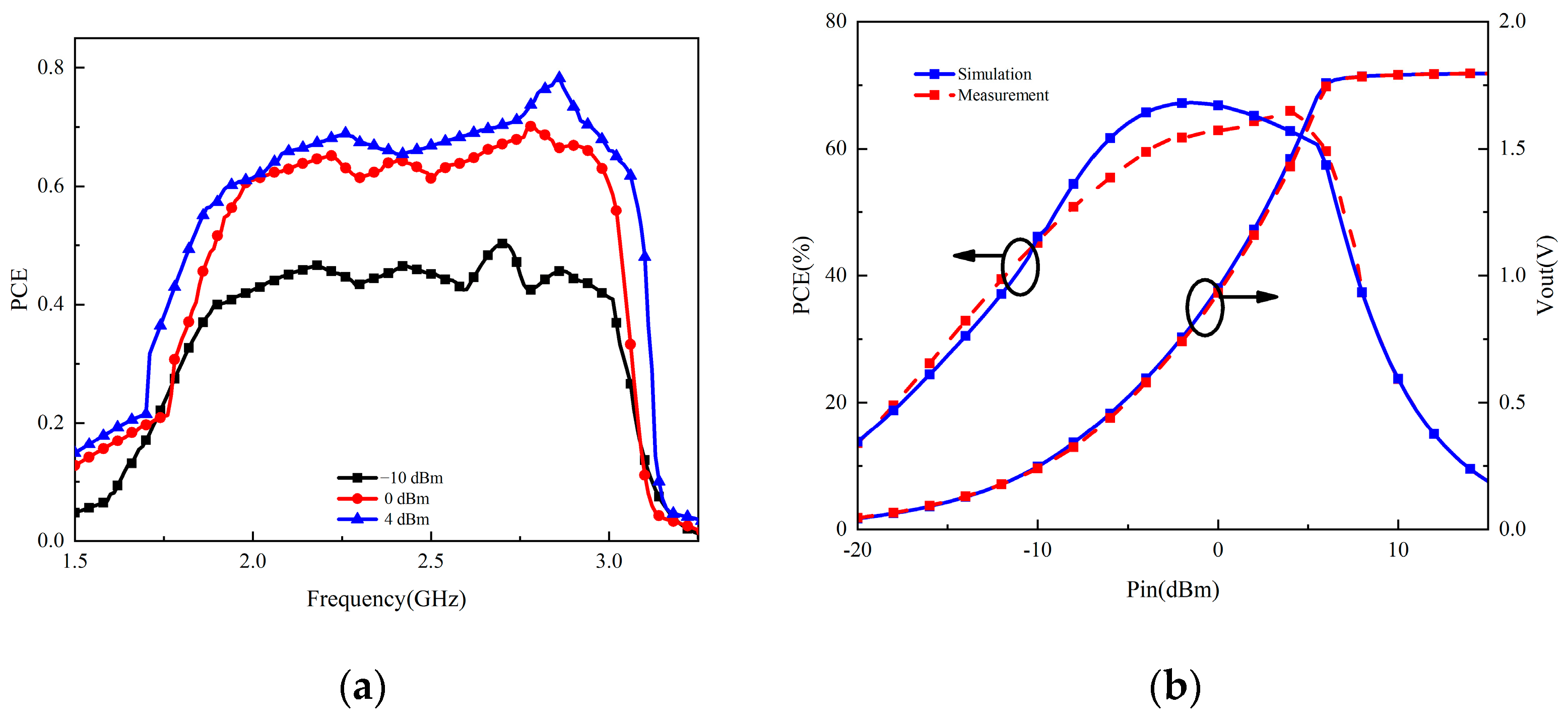A Compact Broadband Rectifier Based on Coupled Transmission Line for Wireless Power Transfer
Abstract
:1. Introduction
2. Broadband Rectifier Design and Analysis
2.1. Design of Part A
2.2. Design of Part B
2.3. Design of Part C
3. Implementation and Experimental Results
4. Conclusions
Author Contributions
Funding
Data Availability Statement
Conflicts of Interest
References
- Shinohara, N. Trends in wireless power transfer: WPT technology for energy harvesting, mllimeter-wave/THz rectennas, MIMO-WPT, and advances in near-field WPT applications. IEEE Microw. Mag. 2021, 22, 46–59. [Google Scholar] [CrossRef]
- Huang, J.; Zhou, Y.; Ning, Z.; Gharavi, H. Wireless power transfer and energy harvesting: Current status and future prospects. IEEE Wirel. Commun. 2019, 26, 163–169. [Google Scholar] [CrossRef] [PubMed]
- Muhammad, S.; Tiang, J.J.; Wong, S.K.; Smida, A.; Ghayoula, R.; Iqbal, A. A dual-band ambient energy harvesting rectenna design for wireless power communications. IEEE Access 2021, 9, 99944–99953. [Google Scholar] [CrossRef]
- He, Z.; Lin, H.; Zhu, H.; Liu, C. A compact high-efficiency rectifier with a simple harmonic suppression structure. IEEE Microw. Wirel. Compon. Lett. 2020, 30, 1177–1180. [Google Scholar] [CrossRef]
- Liu, C.; Tan, F.; Zhang, H.; He, Q. A novel single-diode microwave rectifier with a series band-stop structure. IEEE Trans. Microw. Theory Techn. 2017, 65, 600–606. [Google Scholar] [CrossRef]
- He, Z.; Lin, H.; Liu, C. A novel class-C rectifier with high efficiency for wireless power transmission. IEEE Microw. Wirel. Compon. Lett. 2020, 30, 1197–1200. [Google Scholar] [CrossRef]
- Surender, D.; Halimi, M.A.; Khan, T.; Talukdar, F.A.; Antar, Y.M.M. A 90° twisted quarter-sectored compact and circularly polarized DR rectenna for RF energy harvesting applications. IEEE Antennas Wirel. Propag. Lett. 2022, 21, 1139–1143. [Google Scholar] [CrossRef]
- Aldhaher, S.; Yates, D.C.; Mitcheson, P.D. Load-independent class E/EF inverters and rectifiers for MHz-switching applications. IEEE Trans. Power Electron. 2018, 33, 8270–8287. [Google Scholar] [CrossRef]
- Du, Z.X.; Zhang, X.Y. High-efficiency microwave rectifier with less sensitivity to input power variation. IEEE Microw. Wirel. Compon. Lett. 2017, 27, 1001–1003. [Google Scholar] [CrossRef]
- Halimi, M.A.; Surender, D.; Khan, T.; Kishk, A.A.; Rengarajan, S.R. A multistepped transmission line matching strategy based triple-band rectifier for RFEH/WPT applications. IEEE Microw. Wirel. Compon. Lett. 2022, 32, 1007–1010. [Google Scholar] [CrossRef]
- Halimi, M.A.; Khan, T.; Koul, S.K.; Rengarajan, S.R. A dual-band rectifier using half-wave transmission line matching for 5G and Wi-Fi bands RFEH/MPT applications. IEEE Microw. Wirel. Compon. Lett. 2023, 33, 74–77. [Google Scholar] [CrossRef]
- Li, S.; Cheng, F.; Gu, C.; Yu, S.; Huang, K. Efficient dual-band rectifier using stepped impedance stub matching network for wireless energy harvesting. IEEE Microw. Wirel. Compon. Lett. 2021, 31, 921–924. [Google Scholar] [CrossRef]
- Yue, Z.; Xu, X.; Li, S.; Zhu, Y.H.; Lin, X.Q. Efficient and compact tri-band rectifier with large frequency ratio for WPT. IEEE Microw. Wirel. Compon. Lett. 2022, 32, 1355–1358. [Google Scholar] [CrossRef]
- Wang, S.H.; Zheng, S.Y.; Leung, K.W.; Xia, M.H. A self-matched multi-band rectifier for efficient electromagnetic energy harvesting. IEEE Trans. Circuits Syst. I Reg. Papers 2021, 68, 4556–4565. [Google Scholar] [CrossRef]
- Li, L.F.; Yang, X.; Liu, E.J. A broadband high-efficiency rectifier based on two-level impedance match network. Progr. Electromagn. Res. Lett. 2018, 72, 91–97. [Google Scholar] [CrossRef]
- He, Z.; Liu, C. A compact high-efficiency broadband rectifier with a wide dynamic range of input power for energy harvesting. IEEE Microw. Wirel. Compon. Lett. 2020, 30, 433–436. [Google Scholar] [CrossRef]
- Mansour, M.; Mansour, I.; Zekry, A. A reconfigurable class-F radio frequency voltage doubler from 650 MHz to 900 MHz for energy harvesting application. Alex. Eng. J. 2022, 61, 8277–8287. [Google Scholar] [CrossRef]
- Gyawali, B.; Thapa, S.K.; Barakat, A.; Yoshitomi, K.; Pokharel, R.K. Analysis and design of diode physical limit bandwidth efficient rectification circuit for maximum flat efficiency, wide impedance, and efficiency bandwidths. Sci. Rep. 2021, 11, 19941. [Google Scholar] [CrossRef]
- Liu, L.; Zhang, P.; Weng, M.H.; Tsai, C.Y.; Yang, R.Y. A Miniaturized Wideband Bandpass Filter Using Quarter-Wavelength Stepped-Impedance Resonators. Electronics 2019, 8, 1540. [Google Scholar] [CrossRef]
- Li, C.; Ma, Z.H.; Chen, J.X.; Wang, M.N.; Huang, J.M. Design of a Compact Ultra-Wideband Microstrip Bandpass Filter. Electronics 2023, 12, 1728. [Google Scholar] [CrossRef]
- Zhang, Y.; Shen, S.; Chiu, C.Y.; Murch, R. Hybrid RF-solar energy harvesting systems utilizing transparent multiport micromeshed antennas. IEEE Trans. Microw. Theory Tech. 2019, 67, 4534–4546. [Google Scholar] [CrossRef]
- Gu, X.; Guo, L.; Hemour, S.; Wu, K. Optimum temperatures for enhanced power conversion efficiency (PCE) of zero-bias diodebased rectifiers. IEEE Trans. Microw. Theory Tech. 2020, 68, 4040–4053. [Google Scholar] [CrossRef]
- He, H.; Lin, H.; Wu, P.; Li, Q.; Liu, C. Compact high-efficiency broadband rectifier based on coupled transmission line. IEEE Trans. Circuits Syst. II Exp. Briefs 2022, 69, 4404–4408. [Google Scholar] [CrossRef]
- Zhao, F.; Inserra, D.; Wen, G. Compact and high efficiency rectifier design based on microstrip coupled transmission line for energy harvesting. In Proceedings of the IEEE/MTT-S International Microwave Symposium, Los Angeles, CA, USA, 4–6 August 2020. [Google Scholar]
- Wu, Y.; Sun, W.; Leung, S.; Diao, Y.; Chan, K.H. A novel compact dual-frequency coupled-line transformer with simple analytical design equations for frequency-dependent complex load impedance. Progr. Electromagn. Res. 2013, 134, 47–62. [Google Scholar] [CrossRef]
- Zhao, F.; Inserra, D.; Gao, G.; Huang, Y.; Li, J.; Wen, W. High-Efficiency Microwave Rectifier with Coupled Transmission Line for Low-Power Energy Harvesting and Wireless Power Transmission. IEEE Trans. Microw. Theory 2021, 69, 916–925. [Google Scholar] [CrossRef]
- Nguyen, D.A.; Seo, C. Design of high-efficiency broadband rectifier with harmonic control for wireless power transfer and energy harvesting. IEEE Microw. Wirel. Compon. Lett. 2022, 32, 1231–1234. [Google Scholar] [CrossRef]
- Wu, P.; Huang, S.Y.; Zhou, W.; Yu, W.; Liu, Z.; Chen, X.; Liu, C. Compact high-efficiency broadband rectifier with multistage transmission line matching. IEEE Trans. Circuits Syst. II Exp. Briefs. 2019, 66, 1316–1320. [Google Scholar]
- Bui, G.T.; Nguyen, D.A.; Seo, C. A highly efficient design of broadband rectifier with harmonic suppre ssion transferring for energy harvesting and wireless power transfer. IEEE Microw. Wirel. Compon. Lett. 2023, 33, 1059–1062. [Google Scholar] [CrossRef]





| Parameter | Value (mm) | Parameter | Value (mm) |
|---|---|---|---|
| W1 | 2.26 | L1 | 0.76 |
| W2 | 3.27 | L2 | 5.54 |
| W3 | 5.85 | L3 | 5.68 |
| W4 | 0.30 | L4 | 12.23 |
| G | 5.00 |
| Ref. | Size (mm2) | Substrate | Diode | Frequency (GHz) | Bandwidth | |||
|---|---|---|---|---|---|---|---|---|
| (PCE > 40% 0 dBm) | ||||||||
| [23] | 37 × 10 | F4B | HSMS 2860 | 1.7–2.8 | 49% | N/A | 49% (1.99 GHz) | 78.63% (1.99 GHz) |
| [27] | 46 × 32 | TLY-5 | HSMS 2860 | 1.7–2.8 | 48.9% | N/A | 61% (1.85 GHz) | 82.5% (1.9 GHz) |
| [28] | 36 × 35 | Rogers 4350 | HSMS 2860 | 1.9–3.1 | 48% | 12% (2.5 GHz) | 50% (2.5 GHz) | 75.8% (2.5 GHz) |
| [29] | 22.5 × 22.8 | TLY-5 | BAT 15-03W | 1.8–2.9 | 47% | 28% (2.1 GHz) | 64% (2.1 GHz) | 82.3% (2.1 GHz) |
| Ours | 19 × 21 | Rogers 4003 | HSMS 2860 | 1.82–3.1 | 52% | 44% (2.9 GHz) | 67% (2.9 GHz) | 79.6% (2.9 GHz) |
Disclaimer/Publisher’s Note: The statements, opinions and data contained in all publications are solely those of the individual author(s) and contributor(s) and not of MDPI and/or the editor(s). MDPI and/or the editor(s) disclaim responsibility for any injury to people or property resulting from any ideas, methods, instructions or products referred to in the content. |
© 2024 by the authors. Licensee MDPI, Basel, Switzerland. This article is an open access article distributed under the terms and conditions of the Creative Commons Attribution (CC BY) license (https://creativecommons.org/licenses/by/4.0/).
Share and Cite
Liu, Y.; Xie, G. A Compact Broadband Rectifier Based on Coupled Transmission Line for Wireless Power Transfer. Electronics 2024, 13, 3901. https://doi.org/10.3390/electronics13193901
Liu Y, Xie G. A Compact Broadband Rectifier Based on Coupled Transmission Line for Wireless Power Transfer. Electronics. 2024; 13(19):3901. https://doi.org/10.3390/electronics13193901
Chicago/Turabian StyleLiu, Yan, and Gang Xie. 2024. "A Compact Broadband Rectifier Based on Coupled Transmission Line for Wireless Power Transfer" Electronics 13, no. 19: 3901. https://doi.org/10.3390/electronics13193901






